Q. You stayed on the International Space Station (ISS) for 4½ months. What are your thoughts on the mission?
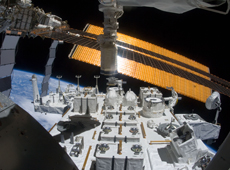
Kibo's Exposed Facility attached to the ISS (Courtesy of NASA)
It was my first long-duration mission in space. Before this flight, I thought my time aboard the space shuttle-while docked, upon arrival, and during departure-could be compared to short sprints, while the time on the ISS would be like running a marathon. But in reality, the first 2 months didn't seem like that at all. After the departure of the space shuttle Discovery, my ride to the ISS, and later the departure of the ISS Expedition 18 crew, which left on the Soyuz TMA-13, only three crew members remained: Russian commander Gennady Padalka, American astronaut Michael Barratt, and myself. All three of us were very busy-as busy as we had been on a shuttle flight. That was unexpected. Later, at the end of May, three new crewmates arrived on Soyuz TMA-15 to join us. This marked the first time we had established a six-member crew aboard the ISS. The increase in crew size finally allowed us to slow down a little and actually get some rest On Sundays, we spent some time looking at our beautiful home planet through the windows of Kibo, the Japanese Experiment Module on the ISS, reading books or listening to our favorite music. Observing the Earth go by beneath our outpost had the most relaxing effect on me.
During the STS-119 mission, which took me to the ISS, we attached the S-6 Truss, a base structure of solar array wings, and during the STS-127 mission, before our return, we completed the assembly of Kibo with the installation of Kibo's Exposed Facility.
Q. How did you manage your health in orbit?
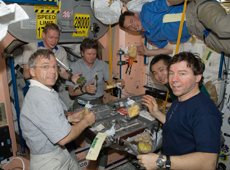
ISS Expedition 20 crew having a meal (Courtesy of NASA)
I had weekly medical conferences with JAXA flight surgeons via video conference, and bi-weekly psychological conferences with a JAXA psychiatrist and a psychologist. Through these interviews, my physical and mental health was thoroughly monitored. I reported on myself, and was given comprehensive advice on such things as nutrition, based on my reports and on medical data acquired in orbit. I think these conferences played a big role in helping me maintain my health in space. Also, the conferences were done privately and in Japanese, so I could communicate with ease. The official languages on the ISS are English and Russian, and when I was speaking with the Flight Control Room at JAXA's Tsukuba Space Center during ISS systems and payload operations, I was required to speak in either English or Russian. I believe that having conferences in my mother tongue played a great part in making me feel comfortable during my stay away from home.
Also, I brought 28 different kinds of Japanese space food with me, which were developed in collaboration between JAXA and various food manufacturers. Eating Japanese food, familiar to me since my childhood, always cheered me up in space. Living so long in a confined environment such as the ISS made me deeply aware for the first time just how big a role food culture plays in providing psychological support in life.
Q. How did you feel when you finished the assembly of the Japanese Experiment Module, Kibo?
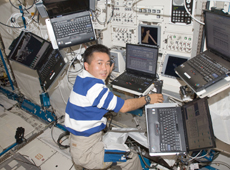
Astronaut Wakata working at Kibo's robotic arm console (Courtesy of NASA)
I saw that Kibo truly is a world-class human space experiment facility. I am very fortunate to be able to take part in the completion of its assembly. Ever since I was selected as an astronaut candidate 17 years ago,
I have worked closely with the team that developed Kibo and the staff members of Kibo's Flight Control Team. At the Tsukuba Space Center, any time when a problem occurred in development tests of the hardware, we all worked together on the solution, making step-by-step progress toward Kibo's launch. When we attached Kibo's Exposed Facility and completed the assembly on orbit, and when we transferred experiment payloads using Kibo's robotic arm I had the privilege of participating in its hardware development, one after another, the faces of all my colleagues in the development and operations team of Kibo appeared in my mind. I feel very privileged to have had the chance to actually work in the Kibo modules on the International Space Station.
Q. How did it feel to use Kibo's robotic arm, which you helped develop?
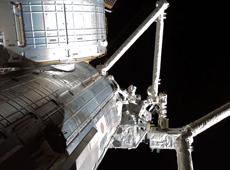
Day 9 of the STS-127 mission. Experiment payload being attached to the Exposed Facility (Courtesy of NASA)
I have supported Kibo's robotics arm development teams of the former National Space Development Agency of Japan, known as NASDA, and of JAXA, as well as of the manufacturing companies as an astronaut representative for many years. In that function, I supported the design of the robotic arm in such areas as the configuration of the control panels for the astronauts, the types and locations of the switches, and the control methods of the robotic arm. As an arm operator, as well as an engineer who participated in the systems development, I consider it very rewarding to have been given the opportunity to actually operate the arm in space.
I used the robotic arm for a payload transfer in orbit for the first time on the ninth day of the STS-127 mission, my return flight to the Earth. It was the day on which we demonstrated the performance of all the Japanese-made technology. The robotic arm, the scientific instruments, and the mechanisms for installing the scientific instruments on the Exposed Facility-everything was integrated in Japan and many components were used in space for the first time. They all performed superbly. I was able to reconfirm the high reliability of Japan's space technology.
Q. How did you find using the Japanese Experiment Module, Kibo, in space?
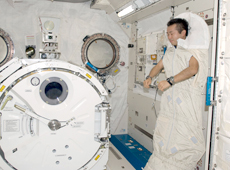
Astronaut Wakata in a sleeping bag in Kibo (Courtesy of NASA)
I found Kibo's Pressurized Module very comfortable, since it is very bright and very quiet. The color of the interior walls and the lighting are very well designed. There is enough light to carry out experiments in the module even with a few internal lights turned off. I slept in Kibo's Pressurized Module many times. It is very quiet there, so I always got a good night's sleep. In terms of both carrying out experiments and living, I think Kibo's design is ergonomically quite remarkable. I hope that the module's merits will be fully appreciated and that the module will get a lot of use.
Q. How was the collaboration with the Kibo Flight Control team?

The Flight Control Room celebrating Astronaut Wakata's 100th day in space
For the first 2 months of my long-duration mission on the ISS, only three astronauts were on board the ISS. On a typical day, we usually worked separately on different kinds of experiments and maintenance tasks. When I worked in Kibo, I was almost always by myself. In such a situation, it's easy to feel isolated and lonely. Talking with the J-COM staff, who communicates with the crew from the Flight Control Room at the Tsukuba Space Center, often cheered me up and helped me get my work done in space.
I especially remember my one hundredth 100th day in space. All the staff gathered in the Flight Control Room in Tsukuba to celebrate. I watched the celebration from orbit by video feed. Seeing their smiles made me feel part of the team that has so greatly supported me during my stay on the ISS. We put enormous trust in each other, and that enabled me to get the job done. I think the fact that we have been able to operate Kibo without any major problems for over a year since the completion of its assembly had a lot to do with the outstanding teamwork.
